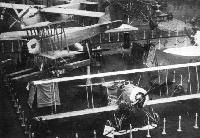Семейство Hanriot H.30
После постройки одноместного истребителя-биплана H.31 с мотором Salmson мощностью 500 л. с. и фюзеляжем, закрепленным на I-образных подкосах между крыльями, компания "Hanriot" вернулась к монопланам с крылом типа парасоль. Самолет H.34 с размещением двух членов экипажа тандемом и мотором Le Rhone 9C мощностью 80 л. с. выполнил первый полет в 1924 году. H.34 создавался как самолет первоначального обучения для ВВС Франции, за ним последовал H.34bis с мотором Salmson мощностью 120 л. с. и стабилизатором увеличенной площади и H.34ter с мотором Anzani мощностью 90 л. с., однако заказов на серийные машины не поступило.
Hanriot H.35, разработанный на основе H.34, предназначался для основной подготовки летчиков, на нем стоял мотор жидкостного охлаждения Hispano-Suiza 8Ab мощностью 180 л. с.; построено 12 самолетов для летных школ компаний "Hanriot" в Шалон-сюр-Сон и "Societe Francaise d'Aviation" в Орли. В апреле 1927 года первый H.35 демонстрировался на аэродроме Куатро-Виентос недалеко от Лиссабона высшим чинам Вооруженных сил Португалии, заинтересованным в приобретении учебных самолетов; интереса самолет не вызвал.
H.36 - развитие машины H.35, сертификат летной годности получен в мае 1925 года. На двухпоплавковом учебном самолете стоял мотор Salmson 9Ac мощностью 120 л. с. Машина демонстрировалась в Югославии летчиком Полем Гилбертом, после чего Югославия заказала 50 самолетов, хотя неизвестно сколько из них реально были поставлены.
ТАКТИКО-ТЕХНИЧЕСКИЕ ХАРАКТЕРИСТИКИ
Hanriot H.35
Тип: двухместный самолет основной подготовки летчиков
Силовая установка: один V-образный восьмицилиндровый ПД Hispano-Suiza 8Ab мощностью 180 л. с. (134 кВт)
Летные характеристики: макс. скорость 185 км/ч; практический потолок 5000 м; дальность полета 320 км
Масса: пустого снаряженного 680 кг; максимальная взлетная 945 кг
Размеры: размах крыла 11,39 м; длина 7,60 м; высота 2,70 м; площадь крыла 22,00 м2
Показать полностьюShow all
Flight, December 1924
The Paris Aero Show 1924
AVIONS HANRIOT
THE Hanriots, Pere and fils, who were among the pioneers not only of French aviation, but of aviation in general, are represented at the Grand Palais this year mainly by school machines of various types, a class of machine with which they have been singularly successful, although they have also on view a single-seater fighter with Salmson engine. Of the school machines it scarcely seems necessary to speak here, beyond placing on record the fact of their presence. One exception is the monoplane two-seater intended for advanced training. This machine, which is shown fitted with a Salmson engine of 120 h.p., is known as the type H.34, and differs somewhat from its prototype, the standard H.D.34, which is normally fitted with 80 h.p. le Rhone engine. As exhibited the machine is equipped with oleo undercarriage of rather neat type, which should further make the machine suitable for the rough handling it may be expected to receive at the hands of semi-skilled pilots. One gathers that the type H.34 is particularly nice to fly, and that it is capable of being stunted so as to enable pilots undergoing advanced training or "refresher" courses to practise all the various manoeuvres which have to be undertaken in the course of an aerial combat. No particulars of the H.34 were available on the stand beyond those relating to the le Rhone-engined machine, and as it appears likely that the figures for weight and performance are materially altered by the substitution of the Salmson engine, no useful purpose is served by giving the figures.
<...>
Показать полностьюShow all
Flight, December 1926
The Paris Aero Show 1926
HANRIOT
THE Avions Hanriot firm, particularly well known for its training aeroplanes, large numbers of which have been supplied to the French and numerous foreign governments, will exhibit three machines: (1) a type H.35 advanced training aeroplane with 180 h.p. Hispano-Suiza engine; (2) a type H.41 training seaplane with 120 h.p. Salmson engine; and (3) a type H.14S ambulance aeroplane with 80 h.p. Rhone engine.
Hanriot H.35 Training Aeroplane
This machine is a strut-braced parasol monoplane which bears a certain resemblance with the Morane-Saulnier training aeroplanes, though, as a matter of fact, the two machines differ considerably in engineering practice.
The H.35 has a composite structure - that is, the wings have duralumin tube spars and lattice work compression members with wooden ribs, the whole being covered with fabric, while the fuselage is built up on four duralumin tube longerons and cross pieces, with wooden fairing members. The fuselage is also covered with fabric, except in the neighbourhood of the engine, where the covering is sheet aluminium. The cabane struts and the lateral bracing struts are faired duralumin tubes, wire-braced.
The landing gear is of the Vee type with a divided, rubber-sprung axle. All the landing gear struts are duralumin tubes.
The ailerons are controlled by means of push-and-pull rods. Dual control is provided ; the front control may be declutched from the pilot's seat (at rear), or may be entirely removed if the machine is not to be used for instruction purposes.
The petrol tank is of the gravity type, and is mounted in the centre section. The oil tank is mounted in the engine compartment, and acts at the same time as oil radiator. Fuel for three hours' flight is carried.
Specification of the Hanriot H.35
Engine, 180 h.p. Hispano-Suiza; span, 11-40 m.; length, 7-47 m.; height, 2-75 m.; wing area, 22 sq. m.; weight empty, 600 kg.; useful load, 200 kg.; fuel load, 150 kg.; weight loaded, 950 kg.; maximum speed, 207 km.p.h.; ceiling, 6,500 m.
<...>
Показать полностьюShow all



